Email Deliverability Guide: Best Practices and Tools to Avoid Spam Folders
You may naively believe that an eye-catching subject line and killer copy are enough for email marketing; however, everything begins with email deliverability and avoiding spam/junk folders.
The success of an email marketing campaign depends on the unremarkable but increasingly important metric that is often overlooked and underappreciated. With a poor email deliverability rate, your email newsletter will never win over prospects. Deliverability has a drastic impact on email campaigns and profit. Therefore, a top priority for every business is to make it high and healthy.
What is email deliverability? How can you improve it? What traps should you avoid? We are going to consider all these in our guide.
What is Email Deliverability?
Email deliverability is the ratio between the number of emails sent to subscribers and the number of emails that make it to subscribers’ inboxes.
It is important not to confuse the email deliverability rate with the email delivery rate. The latter is the number of emails that were delivered to the server. However, it does not mean your email deliverability rate is the same. Emails may end up in spam folders, can be stopped or blocked, and turned down by ISP filters, resulting in a poor email deliverability rate.
The delivery rate depends on your provider’s ability to get emails to recipients, impacting the health of your subscription list. Email deliverability rate is a more complex factor that depends on many things; it is here where your actions carry weight.
With Postcards Email Builder you can create and edit email templates online without any coding skills! Includes more than 100 components to help you create custom emails templates faster than ever before.
Free Email BuilderFree Email TemplatesWhat’s more, there is a catch. Without a good delivery rate, there is no good email deliverability rate. Together, these two form the general picture. Therefore, before improving the email deliverability rate, make sure:
- A provider is trustworthy
- A provider is capable of delivering all your emails
- Hard bounce rates and soft bounce rates are as low as possible
If your proficiency is insufficient in this domain, it’s advisable to collaborate with professionals specializing in email deliverability. Their expertise can enhance your email programs in several technical aspects:
- Navigating complex Mail Transfer Agent (MTA) configurations to ensure optimal routing of your email messages.
- Providing tactics for managing Internet Protocol (IP) reputation and understanding Email Service Provider (ESP) policies to avoid your emails being marked as spam.
- Guiding the implementation of correct Domain-based Message Authentication, Reporting and Conformance (DMARC), DomainKeys Identified Mail (DKIM), and Sender Policy Framework (SPF) records for accurate email authentication.
- Advising on the intricate workings of spam filters, including managing bounce rates and handling feedback loops.
Incorporating their technical proficiency into your email programs can substantially improve your email deliverability rates, ensuring your messages reach their intended recipients successfully.
Why Does Email Deliverability Rate Matter?
Here are the reasons why your email deliverability should be good:
- Inbox placement: If your email deliverability rate is poor, your emails will land in the spam folder. Deliverability is a major factor that decides if your email will make it to the inbox of your leads or customers.
- Domain reputation management: The internal service providers (ISPs) you use to track how recipients interact with the emails you send them. If your email deliverability rate is good, it will enhance your sender’s reputation.
- Engagement Rates: A higher email deliverability means higher engagement, leading to higher open rates, click-through rates, and potential conversions
- Compliance with Regulations: Good deliverability practices require adherence to email regulations like CAN-SPAM, GDPR, and others. Compliance helps avoid legal issues and fines.
All-in-all. email deliverability is not just about ensuring your email reaches the recipient; it’s about ensuring that your entire email marketing strategy is effective, efficient, and legally compliant.
It’s a key factor that can make or break the success of your email marketing campaigns.
Now that you know why email deliverability matters, let’s understand what a good deliverability rate is.
Email Deliverability Checker Tutorial
With Startup App and Slides App you can build unlimited websites using the online website editor which includes ready-made designed and coded elements, templates and themes.
Try Startup App Try Slides AppOther ProductsWhat is a Good Email Deliverability Rate?
Good email deliverability rates fluctuate between 90% and 100%, but ensuring all emails are delivered to inboxes is almost impossible. There is a big chance to get close.

How to Track Email Deliverability?
Tracking email deliverability involves several components and metrics that collectively provide insight into how well your emails are being received.
Here are the key steps and tools to track email deliverability:
Step 1. Start by measuring the delivery rates. It won’t tell you exactly if the email has reached the inbox of the recipient or not, but it’s a good first step in tacking deliverability.
Step 2. Track hard bounces (permanent delivery failures) and soft bounces (temporary issues). High bounce rates can harm your sender’s reputation.
Step 3. Monitor the percentage of emails that recipients actually open. Low open rates can indicate deliverability issues or poor subject line performance.
Step 4. Next, track the click-through rates. It will tell you the percentage of email recipients clicking on one or more links that you send them in their email.
Step 5. If recipients mark your email as spam, it negatively affects your sender’s reputation. Track the rate of spam complaints to gauge recipient satisfaction.
Step 6. Ensure your IP address is not on any blacklists. There are various tools available online to check your status. Mx Toolbox is one such tool.
Note: It’s always good to keep track of your unsubscribe rate, as that could also impact your email deliverability.
Main Reasons for Poor Email Deliverability
If you are experiencing a drop in open- and click-through rates, see an increase in bounce rate, or find out that you are blocked, these are the first signs that something is wrong with email deliverability. Several factors can ruin it. There are four main aspects to watch for.
#1. Reputation
Reputation is your karma that can improve or ruin your email marketing campaign. It is the core of a good email deliverability rate. Fewer complaints, no spam traps, no blacklists, few hard and soft bounces, and some other aspects build a strong email reputation.
#2. Authentication
Important things such as the Sender Policy Framework, digital signatures, and email encryption (TLS) vouch for authenticity. Although all these measures may be challenging, they are worth the effort.
#3. Infrastructure
Consider feedback loops, abuse reporting mails, mixing records for the sender domain, and changing shared IP to the dedicated one. This area is not for newbies. But that does not mean that you cannot handle it. Much like with authentication, it takes some extra time and money but will pay off. It will help to thoroughly analyze the campaign and improve it from various sides, thereby increasing the email deliverability rate.
#4. Content and Design
URL shorteners, overused subject lines, and the use of free email senders can ruin everything. Relevant content, aesthetically pleasing design, responsive behavior, catchy email subject lines, and the perfect balance between images and text can save the day. Together, design and content play a crucial role. Of course, these two are not directly linked to the email deliverability rate. Still, they are responsible for high CTR that signals to ISPs that this email is valuable and the sender is trustworthy.
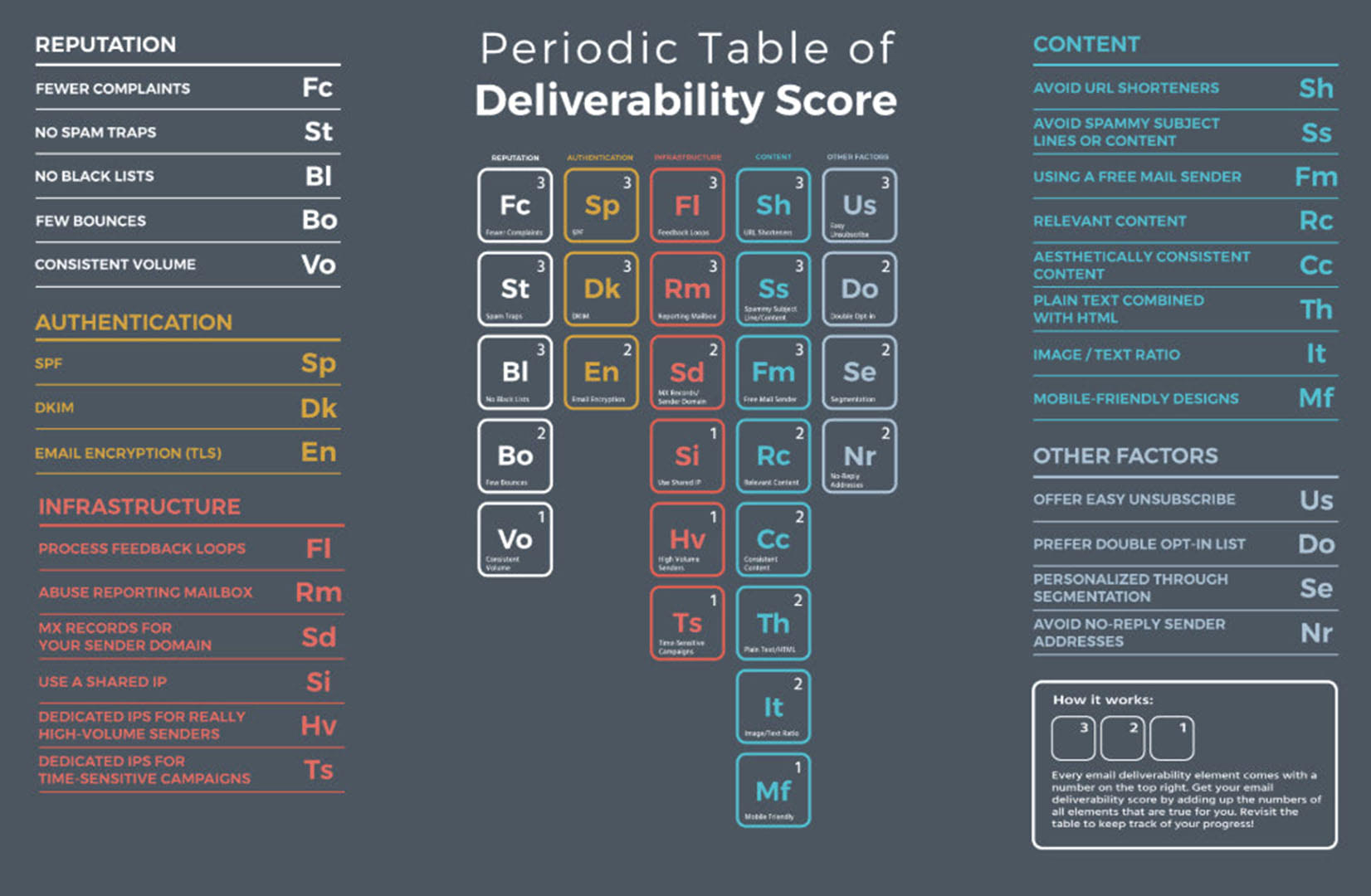
Deliverability Score
This quartet embraces essential issues. To sum up, the most common reasons for poor email deliverability are:
- High spam complaint rate.
- High hard and soft bounce rates.
- Low open rate. A low open rate damages your overall reputation. If subscribers are not interested and do not open your emails, then the ISP may consider them spam.
- Negative sender reputation.
- Absence of custom authentication.
- Use of free email addresses that may be on the blacklist.
- Use of untrusted mail servers.
- Use of spammy subject lines.
- Frequent campaigns that may trigger spam filters.
- Mailing to unknown contacts.
- Being caught in spam traps.
- Switching between email providers too often. This behavior is considered bad by ISPs since all the spammers do this to hide their trails.
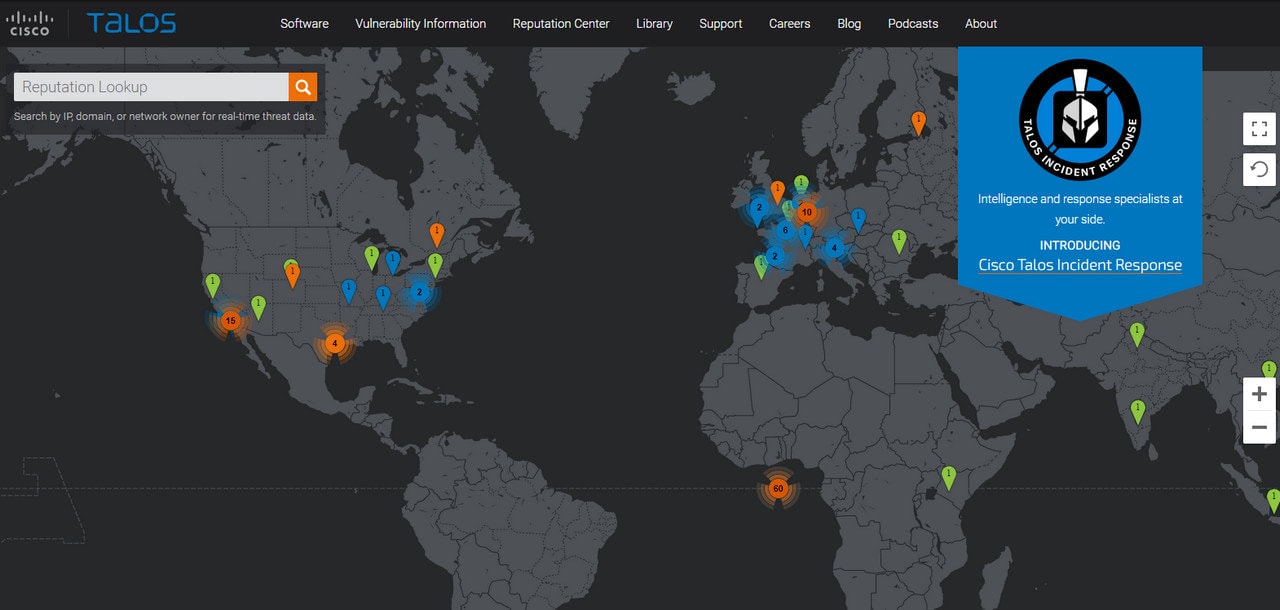
16 Tips for Improving Email Deliverability Rate
To ensure optimal email deliverability, it is crucial to maintain a high delivery rate. Partnering with reliable email deliverability services can greatly enhance your chances of success in reaching your intended recipients. Here are a few ways that you can start to improve email deliverability rates:
- Polish your segmentation and send emails only to engaged users. This will help decrease the number of soft bounce rates that may lead to a good email deliverability rate and open rate.
- Clean your subscription list. Do this regularly to delete all email addresses that are broken or non-existent. Also, remove inactive subscribers or those who have not visited your website for over six months.
- Improve your IP reputation. Make sure you use a trusted provider. Sometimes, it is better to overpay for a premium or exclusive offer rather than suffer from poor performance and bad karma from the sender.
- Warm up your IP address. Gradually increase the number of contacts. Do not use giveaways or similar stuff to gain contacts. Make this process natural. Start with sending a small portion of emails. Do not bombard subscribers with emails every day. Once or twice a week is more than enough to draw attention to your brand and, at the same time, not annoy people.
- Do not purchase an email list since you may end up in spam traps. Remember, getting off of a blacklist will be difficult.
- Use a double opt-in form to harvest engaged subscribers. Do not fall for easy and quick ways. Grow a healthy list and build an audience looking forward to receiving your email. This will help to eliminate the risks of being marked as spam.
- Run your IP address through blacklists. Do this regularly. There are many services where you can check it.
- Keep an eye on complaint feedback loops to sort out the issue on time and not suffer the consequences.
- Have an SPF in place. Use the Sender Policy Framework to specify the server with permission to send your emails. Not only will it tell ISPs that you are trustworthy, but it will also help to prevent others from sending emails in your name.
- Have DKIM in place. This is one of the main factors that help spam filters to understand that you are not a fraud or an attack; digital signatures can do wonders.
- Encrypt your email. To avoid information disclosure and, at the same time, build trust with mailbox providers, set up TLS.
- Use shared IPs with caution. If you have a small company, chances are you have a shared IP since dedicated IPs are a privilege of big companies with large lists. Therefore, use email service providers that can guarantee high quality and a good reputation for their IPs.
- Monitor mailbox provider feedback loops to sort out complaints. Also, keep an eye on the abuse-reporting mailbox.
- Make the brand work for you. Use your company name in the “from” line. It will help to build credibility.
- Do not use a personal Gmail address. Gmail penalizes emails sent from its addresses outside of Gmail. Therefore, you risk spoiling your karma.
- Run your emails through pre-launch checklists to eliminate all the common mistakes.
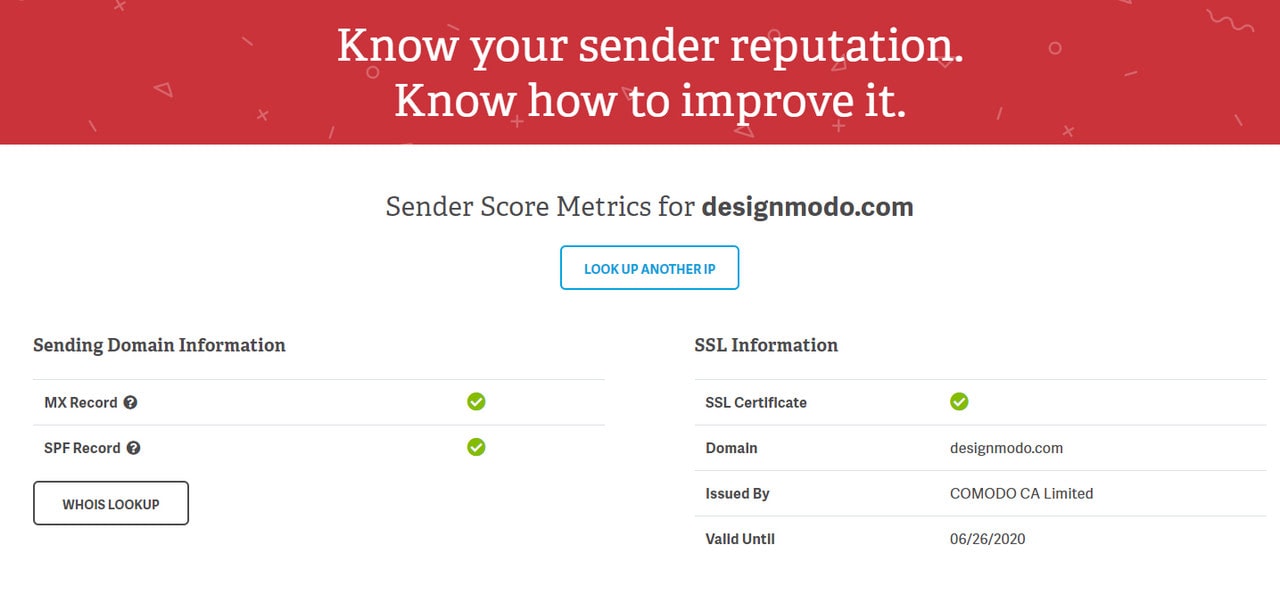
4 Tips for Improving Email Deliverability Rate with Design and Email Content
Along with all this advice, you need to refine the copy and design. Several helpful tips will help to avoid spam marks.
#1. Do not use spammy words in the subject line
For instance, phrases like “FREE!!!” may guarantee a place in a spam folder. However, it does not mean that you should never use it. Use it carefully. Put meaning inside the subject line. Make it fit the theme of the copy. You can use emojis and brand-specific features. Consider our list of subject lines for Black Friday and Cyber Monday campaigns to see how it should be done.
#2. Provide subscribers with an easy way to unsubscribe
If something goes wrong and your contact does not want to receive more emails, it is better to provide an option for unsubscribing rather than marking your email as spam.
#3. Do not use URL shorteners
Spammers like link shorteners. Therefore, they may be considered spam. What’s more, a masked link does not provide any information about its destination, may scare away prospects, and, as a result, decrease the click-through rate.
#4. Make the design responsive and mobile-friendly
It is vital to provide a consistent experience on all screen sizes. If users get a total mess instead of a perfectly designed copy, they can easily reject it or, even worse, mark it as spam.
Therefore, make the design responsive and mobile-friendly. Use Postcards, an intuitive HTML email builder, for this task. Build newsletters with modern design and responsive behavior that will increase CTR and help your email deliverability rate.

4 Technical Elements of Improving Email Deliverability Rate
To avoid being impersonated by spammers, you must embrace the issue’s technical side. It means you need to master DKIM, SPF, TLS, and Dedicated IP.
#1. Dedicated IP
As mentioned, dedicated IP is a privilege of big companies with large-volume senders. The main advantage of dedicated IP over shared is its better reputation. Therefore, the email deliverability rate is higher.
So what can you do? First, you can get a dedicated IP. Second, you can regularly check your shared IP to find out whether it is blacklisted or not. Finally, you can delegate this issue to email marketing software platforms that monitor their IPs and quickly sort out all the problems.
#2. DKIM
DomainKeys Identified Mail, or DKIM, is a digital signature. It helps senders to associate a domain name with email. In other words, you can sign your newsletter with a signature that prevents hackers from impersonating you.
When you create a “signature,” MTA (mail transfer agent) creates a “hash value,” a unique string of characters. After the recipient’s server receives your email, it will undergo verification. If something is wrong, the email is altered and should be stopped. This way, you may ensure that only your newsletters pass the first barrier.
#3. SPF
Sender Policy Framework, aka SPF, is another powerful technical tool that protects your identity and emails from spam hackers. While DKIM uses a domain name, SPF leverages IP addresses to create a strong, unique link between you and your email. In other words, it tells recipients’ email servers what IP addresses are allowed to send emails from you. Again, it will ensure that only your email will meet the criteria.
Note that SPF and DKIM collaborate perfectly. Together, they may guarantee your authenticity.
#4. TLS
Transport Layer Security, aka TLS, is one of the standard protocols for encrypting emails. Along with SSL and STARTTLS, it is used to secure the connection between the sender and recipient. Since only the server and client have the keys used for decryption, no one can intrude. Therefore, it is highly recommended to use it to add an extra level of security.
While all these terms may sound confusing, the good news is that if you are using a popular email marketing service like Mailchimp. Chances are the platform has already done it for you. All you need to do is configure some options. Therefore, do not neglect these tips. They can be easily implemented with the help of a marketing automation platform, bringing about a high email deliverability rate.
6 Best Email Deliverability Tools
We have also compiled a list of necessary email deliverability tools so that you can monitor the situation.
#1. Unspam.email
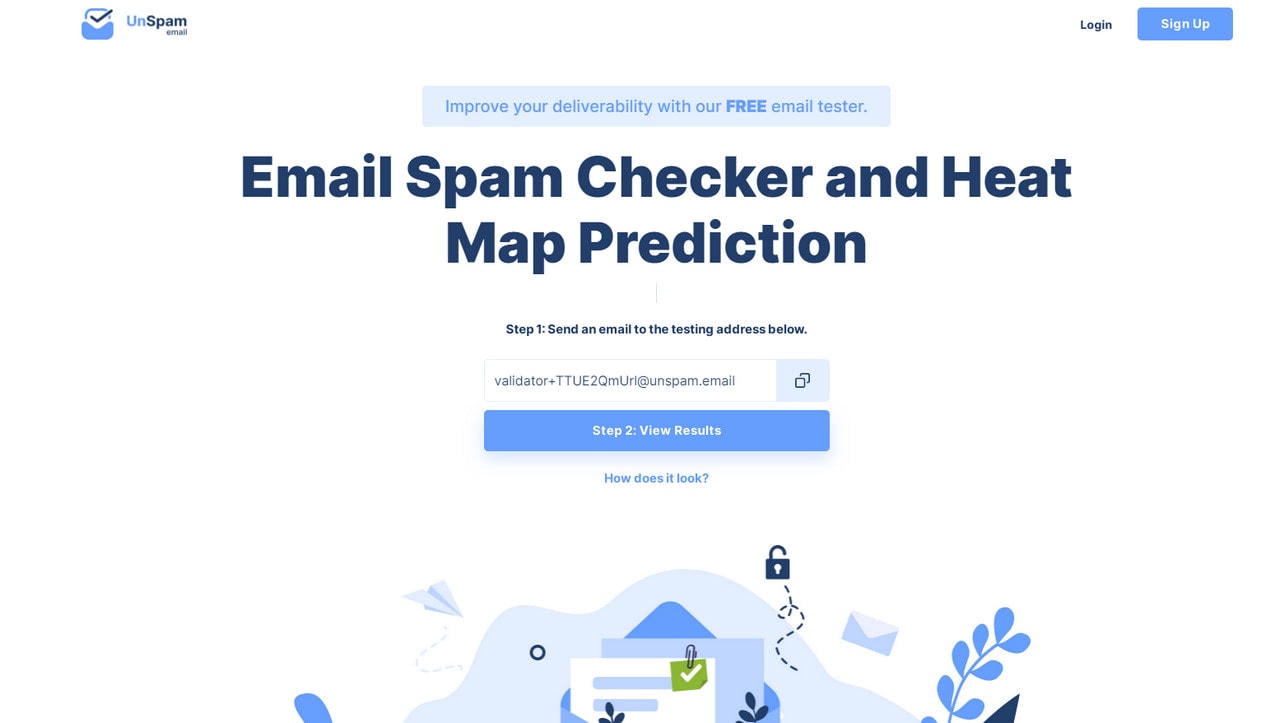
Although Unspam can’t boast of a 20-year history – it is a relevantly new service – nevertheless, its team is perfectly aware of what it takes to create an email design that meets all the current requirements. They have done a great job providing a reliable and all-embracing platform for analyzing your emails. If you want to enjoy excellent deliverability and ensure your campaign’s success, you should certainly try it. They also offer email deliverability consultant services. You can take advantage of the best deliverability experts in the email industry.
Unspam comes with lots of helpful instruments.
- First and foremost, it has a thorough spam check with numerous parameters taken into account.
- Second, it inspects your email on accessibility, which is increasingly vital.
- Third, it has an email preview where you can see your design across various popular devices, platforms, and operating systems.
- Fourth, it analyzes a copy for spam words, broken links, and bad resources.
- Finally, it makes a heat map prediction that lets you improve your design and structure to get better click-through rates.
Like the previous example, this online instrument has been with us for ages. It shows a detailed report of what is wrong with your email and provider so that you can fix the situation before doing actual damage. In addition, the tool also has SPF and DKIM checks that, as we know, are vital for a reasonable email deliverability rate.
#2. Spam Testing
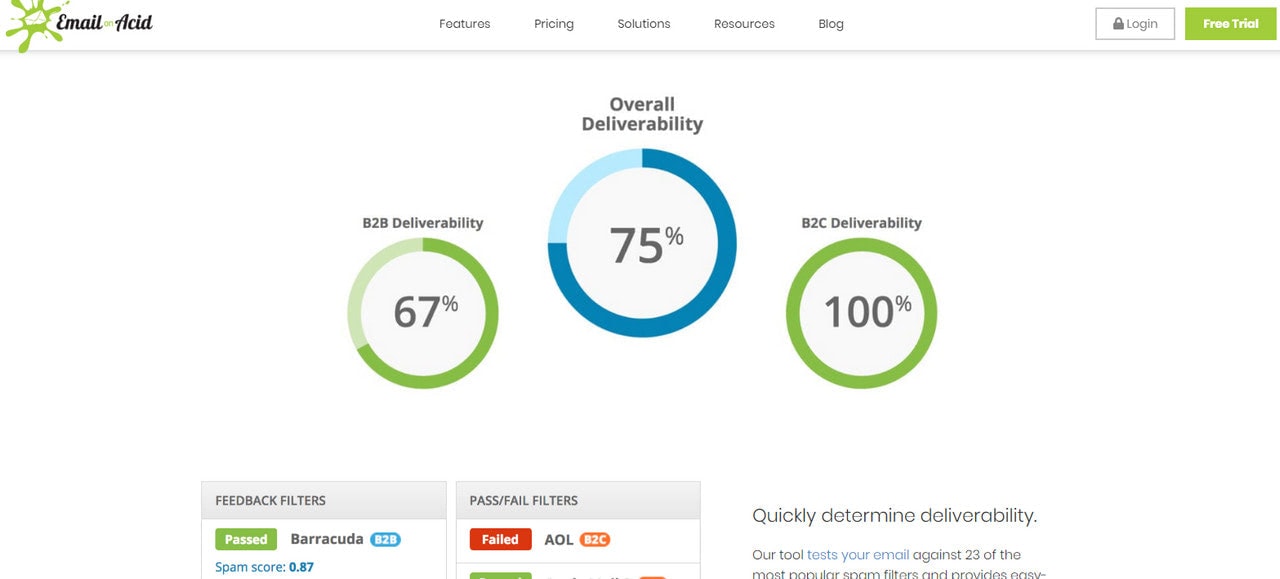
Spam Testing was created to check your email against spam filters. The test includes 23 popular filters to identify the email deliverability rate accurately. It also runs IPs that you use through various blacklists so that you can find out whether you need to change the provider or not.
#3. Spamhaus

Spamhaus has a rich history. Established 20 years ago, it still occupies the leading position when it comes to testing your IP and Domain against blacklists. You will know if your IP is listed on SBL, XBL, or PBL or if your domain is listed on DBL. Along with the report, the service supplies helpful instructions on how to get out of these lists and regain your email-sending karma.
#4. Sender Score
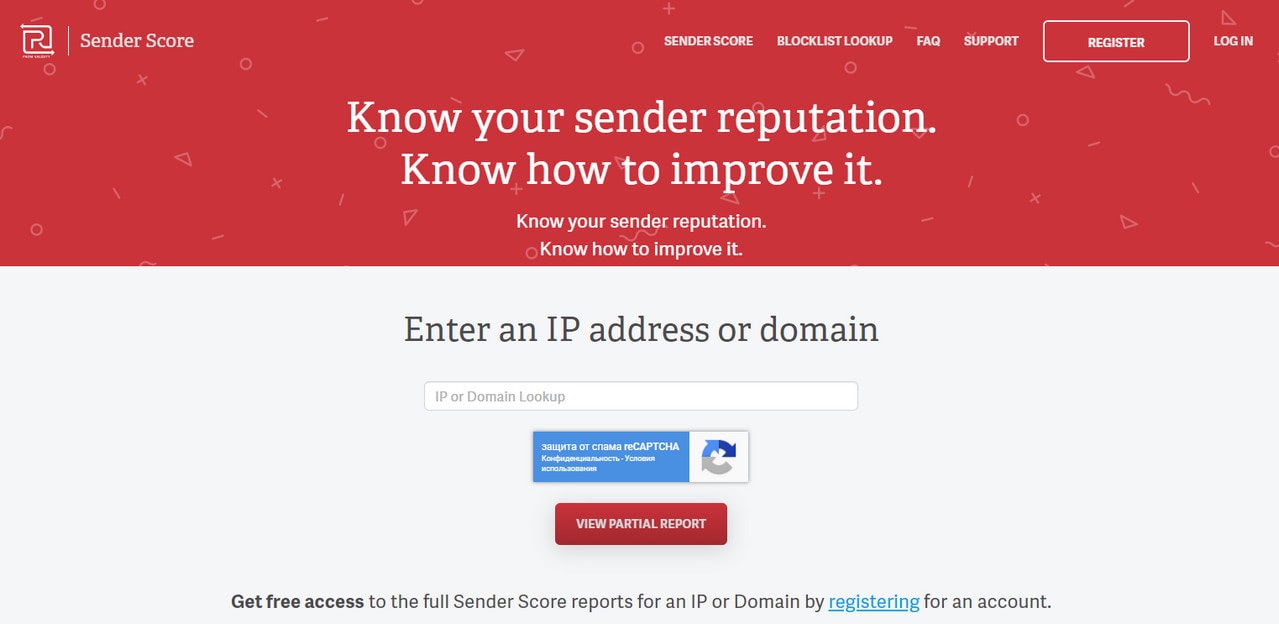
Sender Score measures the health of your sender. Taking into account such important factors as spam complaints and industry blacklists, it identifies the reputation. Based on the result, the tool offers helpful solutions to improve the situation. What’s more, here you can also find the Blocklist Lookup tool to check whether your IP is on the blacklist.
#5. Spam Testing tool by GlockApps
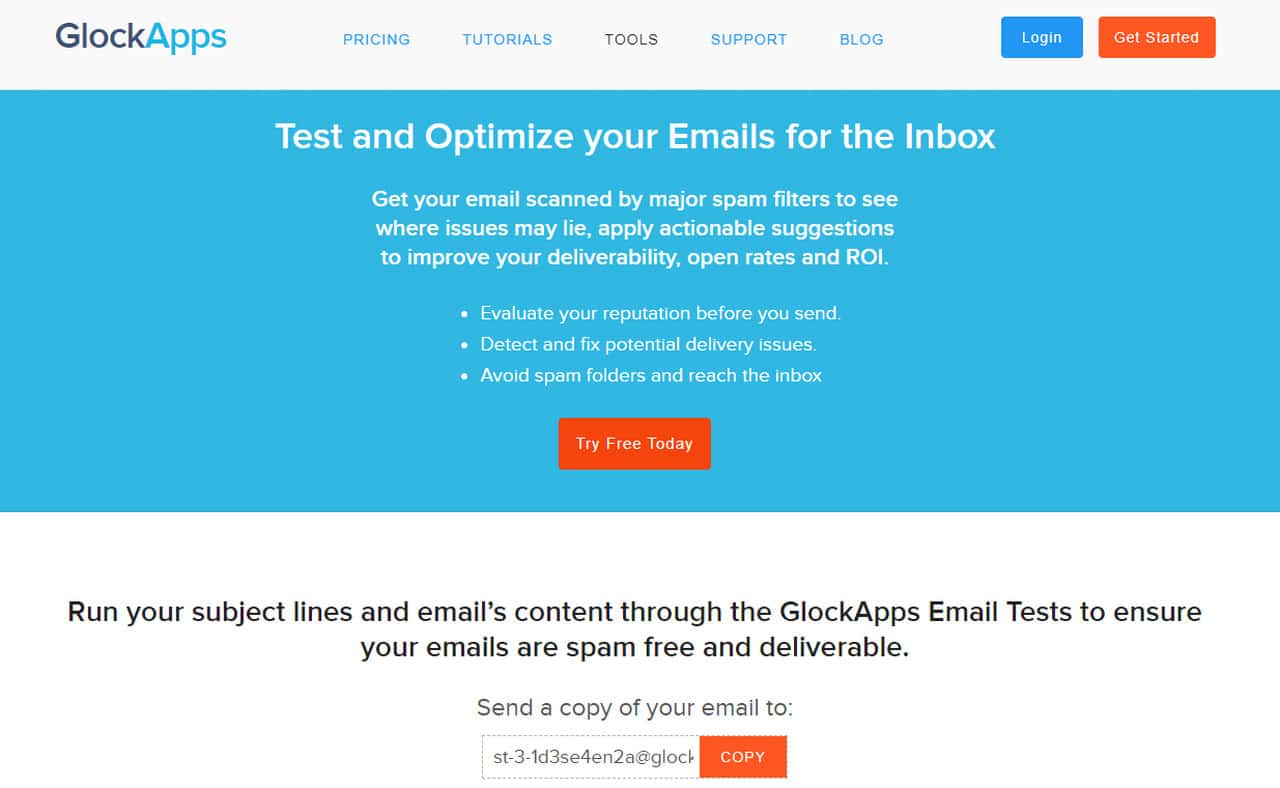
GlockApps offers a tool to scan emails, identify risky content, track delivery duration, and more. It will calculate a sender’s reputation, detect potential delivery problems, and provide solutions to fix issues and avoid spam folders. These will help improve the email deliverability rate and generate more sales.
#6. MXToolbox
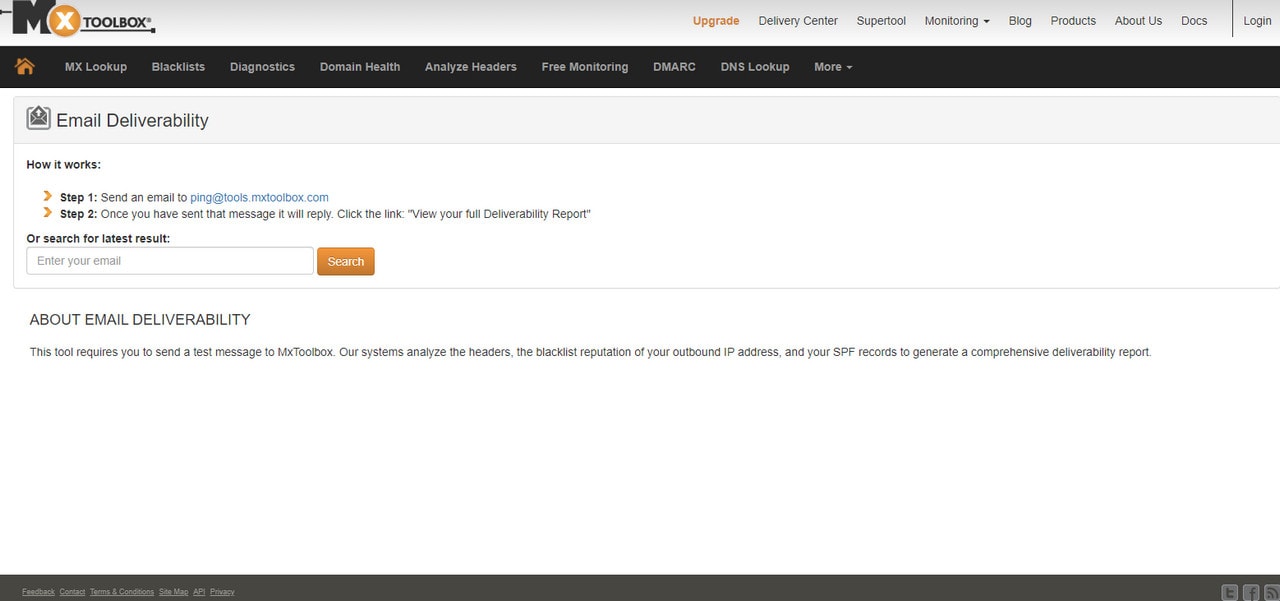
MXToolbox is one of the most powerful and helpful instruments on the web. It has a variety of tests: MX Blocklist Lookup, Diagnostics, Domain Health Check, Deliverability Check, Headers Analyzer, DNS Lookup, and more. It is a pure treasure for email marketers who want to improve not only the email deliverability rate but also the entire email marketing campaign. A free account allows you to monitor your email as well as get access to troubleshooting information.
Wrapping Up
Do your perfectly designed and polished email newsletters make it to the users’ inboxes? This is the first issue that should concern you while developing an email marketing campaign. If the email deliverability rate is low, all your efforts to create a high-converting email will be in vain. Without excellent email deliverability, you may forget about good open rates and conversion rates. Therefore, make sure it is as high as possible.
To do this, keep an eye on such vital things as sender reputation, authentication, blacklists, proper segmentation, healthy subscription list, non-spammy subject lines and content, responsive design, and just follow the best practices of email marketing and email design trends.







